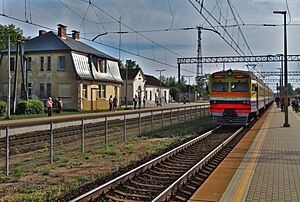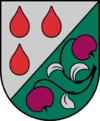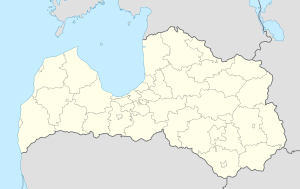Olaine facts for kids
Quick facts for kids
Olaine
|
|||
|---|---|---|---|
|
City
|
|||

Railway station in Olaine
|
|||
|
|||
| Country | |||
| Municipality | Olaine Municipality | ||
| Town rights | 1967 | ||
| Area | |||
| • Total | Lua error in Module:Wd at line 1,575: attempt to index field 'wikibase' (a nil value). km2 (Formatting error: invalid input when rounding sq mi) | ||
| • Land | Lua error in Module:Wd at line 1,575: attempt to index field 'wikibase' (a nil value). km2 (Formatting error: invalid input when rounding sq mi) | ||
| • Water | Expression error: Unexpected < operator. km2 (Formatting error: invalid input when rounding sq mi) | ||
| Population
(2024)Lua error in Module:Wd at line 1575: attempt to index field 'wikibase' (a nil value).
|
|||
| • Total | 9,908 | ||
| Time zone | UTC+2 (EET) | ||
| • Summer (DST) | UTC+3 (EEST) | ||
| Postal code |
LV-2114
|
||
| Calling code | +371 67 | ||
| Number of city council members | 11 | ||
| Website | http://www.olaine.lv | ||
Olaine is a city in Olaine Municipality in the Vidzeme region of Latvia. It became a city in 1967. In 2020, about 10,668 people lived there.
Contents
History of Olaine
How Olaine Got Its Name
The name Olaine comes from an old church. This church was called the Saint Olaf Church. It was built in the 1600s. This was when Sweden ruled the area. The church was near a small stream called Olainīte.
The original church site is now a village. It is called Jaunolaine, which means "New Olaine." This village is about two kilometers from the modern city. An old cemetery still remains at this historic spot.
From Train Stop to City
In 1868, a train stop was built near the old church site. It was named "Olai." This stop was on the railway line between Riga and Mitau. After Latvia gained its independence, the name "Olai" was changed. In 1919, it became "Olaine." This change was part of making place names more Latvian.
Growing with Peat and Industry
The modern city of Olaine grew because of peat. Peat is a type of soil made from decayed plants. It is used for fuel and in gardening. People started digging peat on a large scale in 1939.
More factories were built in the area. Many workers were needed for these new jobs. So, the first homes in what is now Olaine were built in 1940. Today, a company called "Olaines kūdra" processes peat. It is part of a larger German company.
Olaine is also home to Olpha. This is the second largest company in Latvia that makes medicines.
Twin Towns and Sister Cities
Olaine has special friendships with other cities around the world. These are called "twin towns" or "sister cities." They often share ideas and cultures.
Olaine is twinned with:
Notable People from Olaine
Many interesting people have come from Olaine. Here are a few of them:
- Rustams Begovs - A Latvian hockey player.
- Žaneta Jaunzeme-Grende - A Latvian politician.
- Dmitrijs Miļkevičs - A Latvian athlete.
- Jānis Kuzmins - A world champion in slalom skateboarding.
See also
 In Spanish: Olaine para niños
In Spanish: Olaine para niños




